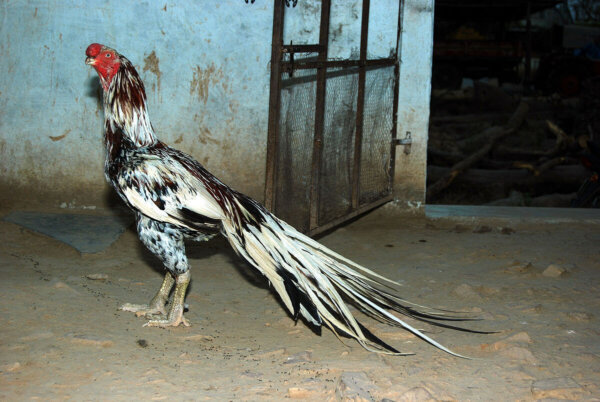
- Purpose: Meat
- Eggs: Brown
- Egg Size: Medium
- Color: Red-Brown, Brown, Brown-Black
- Comb Type: Small
If ever there was a bird who you wanted on your side in a fight, the burly Asil would be an excellent choice. Cocks, hens, and even chicks will fight others with stamina and strength, attesting to the muscly breed’s long history as a fighting bird. The Asil is a highly aggressive chicken–even the chicks are belligerent!
With a fierce look, distinctly upright carriage, and muscles like a bodybuilder, everything in this chicken lets you know that it is ready to defend itself from a potential threat.
Handlers report, however, that this brightly-colored, intelligent breed is quite responsive and tame when it comes to humans. With a small comb and game bird survival instincts, it will also fare well free-ranging in most climates.
The hens also share the fierceness of their male counterparts, and will staunchly defend their chicks from any threat, including snakes. Owners claim that you could find no better brood mother, comparable or even superior to the well-known brooding abilities of the Silkie hen.
This Is Not The Chicken For Beginners
If you are new to chicken keeping, or just starting out with a small flock, the Asil will probably be too much for the beginner to handle. Though the cocks are apparently quite gentlemanly when it comes to people, they have no such love for their own kind. As with many ancient game breeds, the cocks, and even the hens, may need to be kept in their own spaces, apart from other chickens.
What’s The Yield?
If you are looking for a dependable egg-layer, pretty much any other bird would be a better choice than the Asil. With a typical two to four brown eggs a year, Asil hens will not earn their keep by producing your daily omelet. What they lack in egg production, however, they make up for in muscle–particularly in large amounts of breast meat. Though they are slower growing than other meat breeds, these chickens are incredibly muscled. So muscled, in fact, that they were among the breeds used to make the modern broiler bird.
As with many breeds formerly used solely for fighting, these beautifully feathered chickens are starting to find new spheres of influence in the exhibition ring. The color range of this type is fascinating and huge, with variations to make your head spin.
What’s In A Name?
You’ll find several different transliterations of the breed’s name. Aseel, Asil, Asli, and Azeel are all possible. This term is highly respected in Muslim culture, meaning “of pure descent”, “noble”, or “authentic.” The presence of an Arabic name in an Indian chicken is a historical clue of the period when Islamic rule passed over northern India in the 7th century. In their native India and Pakistan, many variations have specific, indigenous names based on their coloration and specific beak shape.
Pictures Of Asil Chickens
Resources
- The Asil — General Breed Information, Asil Community
- Aseel/Asil, BackYard Chickens
- The Field Guide to Chickens, Pam Percy
- Aseel Chicken, Livestock Conservancy
- Aseel, My Pet Chicken
- The Aseel (or Asil), Feathersite
- Asil (Aseel) Chickens, Poultry Keeper








































